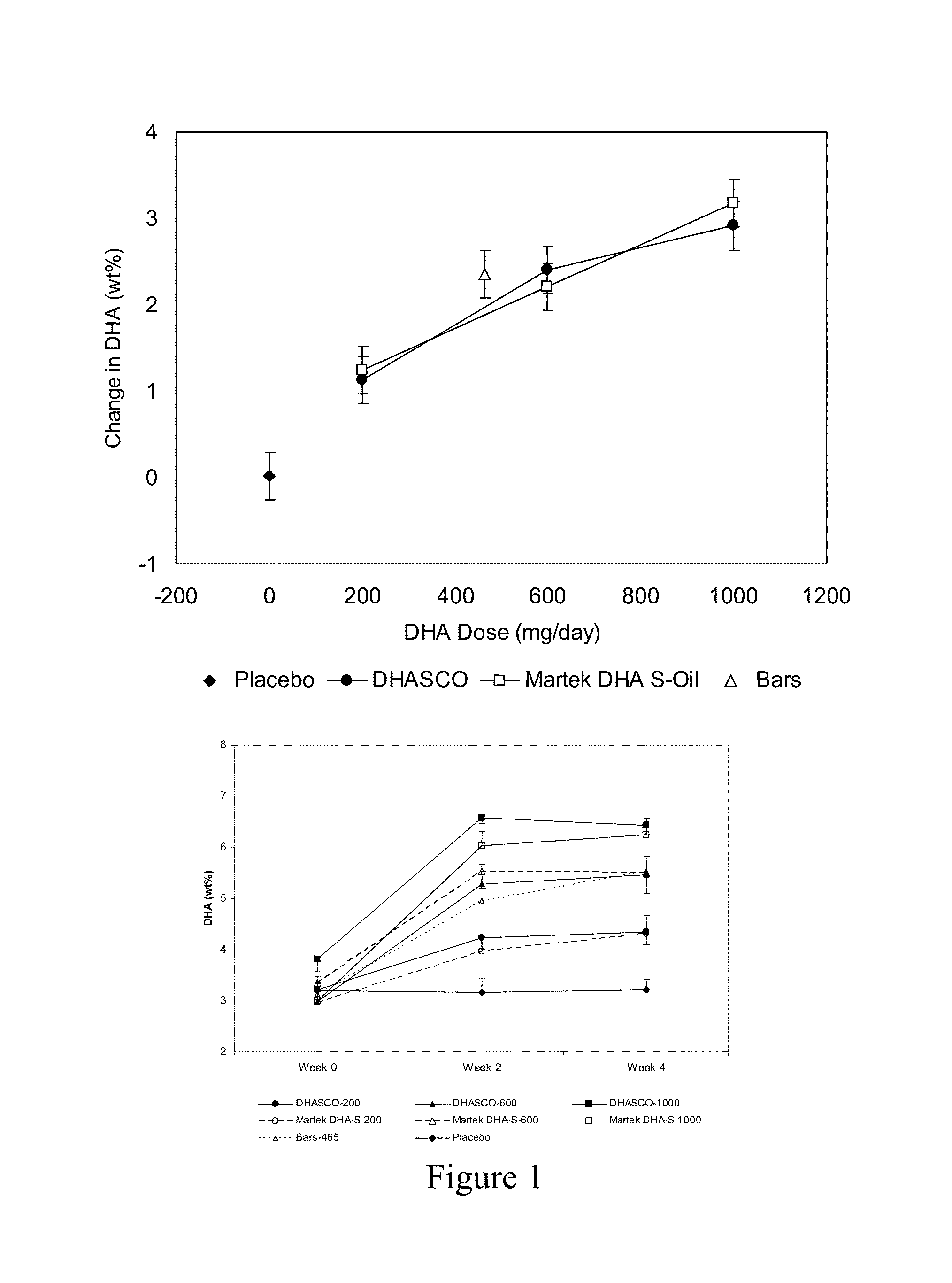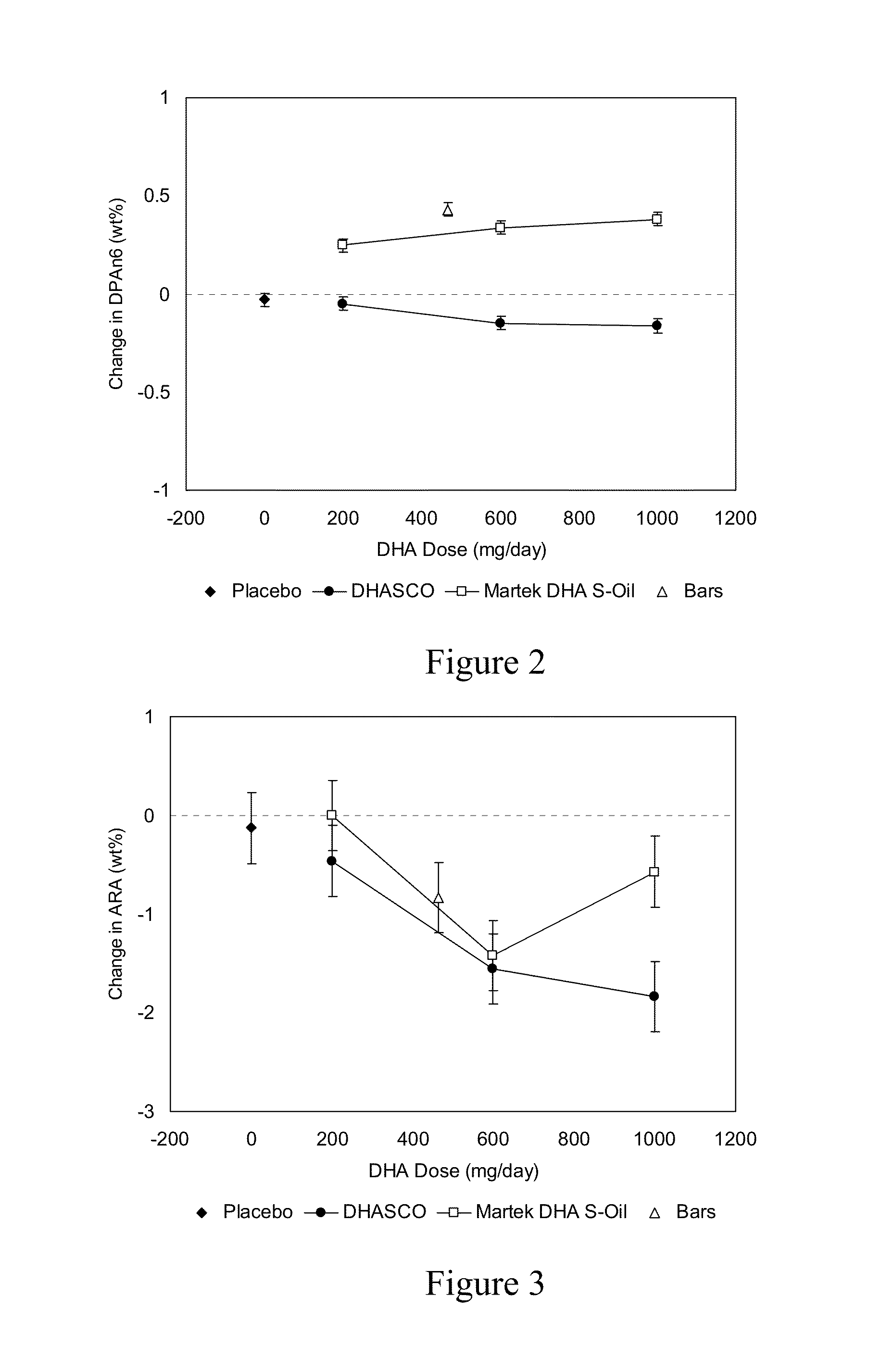Use of DPA(n-6) Oils in Infant Formula
a technology of dha and n-6) oils, which is applied in the field of infant formula preparation, can solve the problems of increasing the content of dha, and low efficiency, and achieves the effects of reducing or preventing the associated decline in reducing or preventing the decline of reducing the plasma level of ara
- Summary
- Abstract
- Description
- Claims
- Application Information
AI Technical Summary
Benefits of technology
Problems solved by technology
Method used
Image
Examples
example 1
DHA Bioequivalence Study in Adults
[0138]This Example shows dose dependent retroconversion of DPA(n-6) to ARA in the presence of DHA in adults.
[0139]To study the effects of DHA-rich Schizochytrium (Martek DHA™-S) oil and DHA-rich Crypthecodinium (DHASCO®) oil supplementation on plasma fatty acid content, healthy adults having an average age of approximately 38 years were randomized into treatment groups supplemented with gelatin capsules delivering either 0, 200, 600 or 1,000 mg DHA per day for a total of 4 weeks. This study was an eight-arm, prospective, randomized, parallel group, bioequivalence study using three doses of DHA (200, 600 or 1000 mg DHA per day) from either DHASCO® or Martek DHA™-S capsules, placebo capsules or a single dose of DHA (465 mg per day) from Martek DHA™-S nutritional bars for a four-week treatment period. Among groups consuming capsules, the study was double-blind and placebo controlled.
[0140]Blood samples were collected at baseline and following four week...
example 2
DHA-S Bioavailability Study in Children
[0144]This example shows dose dependent retroconversion of DPA(n-6) to ARA in the presence of DHA. To study the effects of DHA-rich Schizochytrium oil (Martek DHA™-S Oil) supplementation on plasma fatty acid content, healthy children aged 4 to 6 years were randomized into two treatment groups supplemented with of chewable gelatin capsules delivering either 200 mg or 400 mg DHA per day for a total of 4 weeks. There were approximately 20 subjects per treatment group. The source of DHA was the DHA-rich triglyceride oil derived from Schizochytrium sp. (Martek DHA™-S Oil), which contains approximately 400 mg / g DHA, 150 mg / g DPA(n-6), 11 mg / g EPA, and 2.5 mg / g cholesterol, with the balance of common saturated and unsaturated fats, and minor sterol and carotenoid components. Subject weights ranged from 15.3 to 25.4 kg, with an average of 18.8 kg. Weight-normalized average DHA intake levels were calculated to be 10.6 mg DHA / kg / day at the 200 mg DHA / day...
example 3
Maintenance of ARA Levels by DPA(n-6) in a Rats In Vivo
[0147]Sprague Dawley rats were fed an AIN-76A purified diet containing various amounts between 0 to 3% of Martek DHA™-S oil or DHASCO® oil for 28 days after which blood was collected. Plasma was harvested and stored at −80° C. until fatty acid analysis. Fatty acid levels were determined in whole plasma. Briefly, internal standard (23:0) was added to the plasma samples and lipids were extracted using the method of Folch. Extracted lipids were saponified with 0.5N NaOH in methanol, and the resulting fatty acids were methylated using 14% BF3 in methanol and then extracted with hexane. The fatty acid methyl esters were separated by capillary column gas chromatography on an Agilent Series 6890 System equipped with a 30 m FAMEWAXT™ (Restek, State College, Pa.) column using a 48:1 split flow ratio with helium as a carrier gas and a programmed temperature gradient (130 to 250° C.). Fatty acid methyl esters were identified by flame ioniz...
PUM
| Property | Measurement | Unit |
|---|---|---|
| time | aaaaa | aaaaa |
| temperature | aaaaa | aaaaa |
| weights | aaaaa | aaaaa |
Abstract
Description
Claims
Application Information
 Login to View More
Login to View More - R&D
- Intellectual Property
- Life Sciences
- Materials
- Tech Scout
- Unparalleled Data Quality
- Higher Quality Content
- 60% Fewer Hallucinations
Browse by: Latest US Patents, China's latest patents, Technical Efficacy Thesaurus, Application Domain, Technology Topic, Popular Technical Reports.
© 2025 PatSnap. All rights reserved.Legal|Privacy policy|Modern Slavery Act Transparency Statement|Sitemap|About US| Contact US: help@patsnap.com



